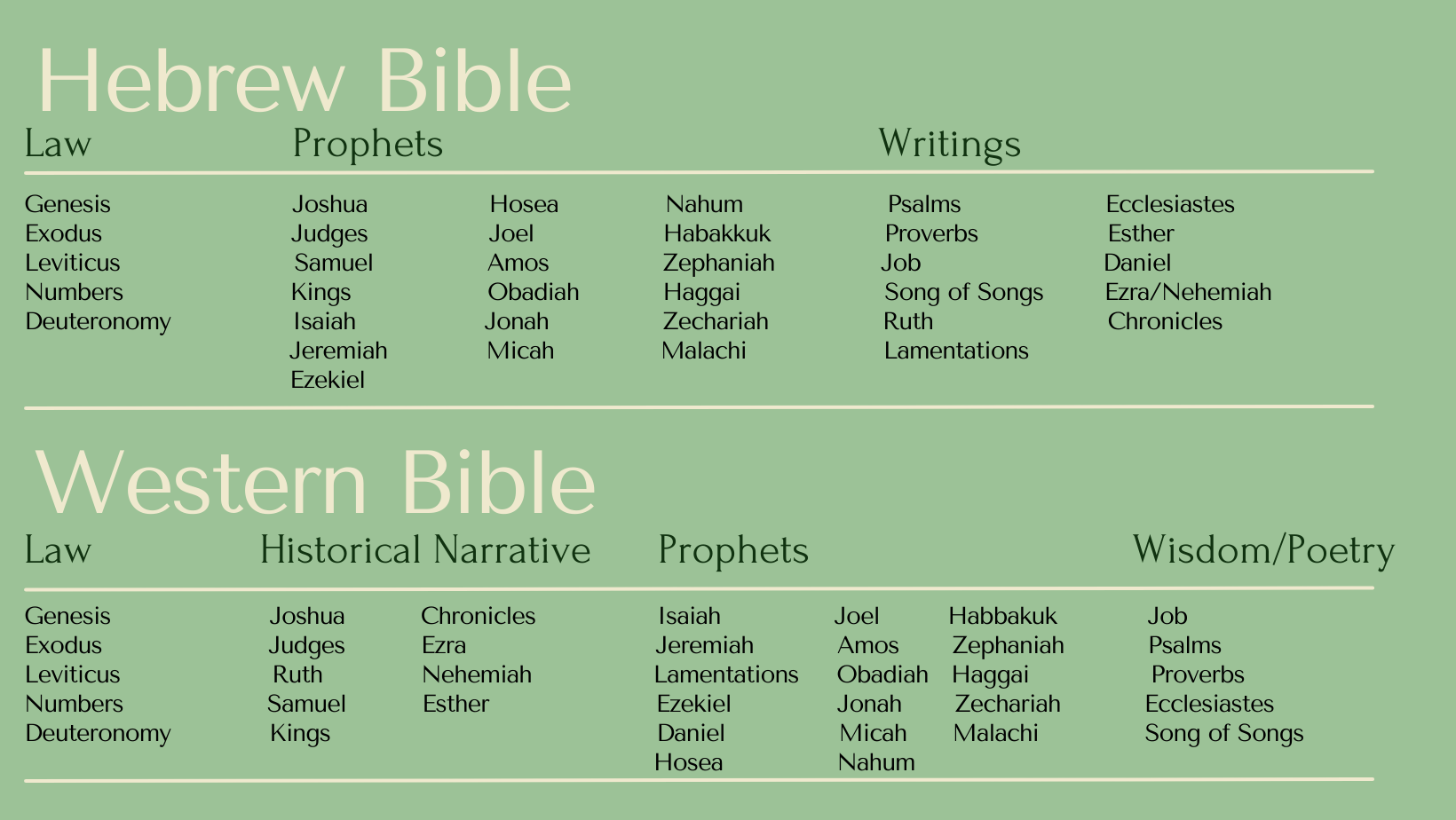Programmes about organising your home have become very popular in recent years and it’s helpful to have your home in some sort of organised form. It makes little sense to keep your gardening tools in your bedroom or your pots and pans in your lounge. Where you locate your possessions is an indication of what those possessions are used for.
When it comes to the Bible, you might be surprised to learn that there are two ways of ordering the Old Testament books. In our western Bibles, the Old Testament books are ordered by genre: law, historical narrative, poetic/wisdom books and finally prophets. Chronology, authorship and length also influence the order so the book of Ruth comes after Judges, because it is a narrative that happened at the time of the Judges.
The Hebrew Bible has exactly the same content but orders the books differently. If you look at the table below, you’ll notice a lot of similarities. Both begin with the Law (or the Pentateuch) which is significant because they are foundational to everything that follows. However Ruth doesn’t appear after Judges and Chronicles doesn’t follow Kings. Then it’s straight on to the prophets and finally amongst the poetic and wisdom books we find books like Esther, Daniel and Ezra-Nehemiah (which is classed as one book).
An authentic way of organising
After his resurrection, Jesus appeared to his disciples and referred to a threefold division of the Old Testament (Luke 24:44). He explained that everything in the ‘Law of Moses, the Prophets and the Psalms’ was written about him. Here, Jesus was using ‘Psalms’ as the first book of the Writings to refer to the whole of that section.
On another occasion, Jesus referred to the martyrdom of prophets from Abel to Zechariah (Luke 11:49-51). He’s not doing an A to Z of martyrs, as Zechariah’s Hebrew name begins with the 7th letter of the Hebrew alphabet! Rather, Jesus is referring to the first and last martyrs in the order of the Hebrew books. Abel is martyred at the beginning in Genesis 4, and Zechariah is martyred in 2 Chronicles 24 which comes towards the end of the Hebrew Old Testament. This shows that Jesus would have used the Hebrew order – an allusion which is lost in our Western order.
We know from historical sources that this threefold division was already well established as the order of the Hebrew Bible centuries before Jesus’s birth and continued for centuries after.
A better way of organising
We all have different ways of organising our belongings and we usually keep things where we are going to use them. It wouldn’t be wrong to keep your gardening tools in your bedroom, or your pots and pans in the lounge but the position we usually keep these things in highlights their purpose. Likewise, it’s not wrong to organise your Bible books, as most of our Bibles do, with the western order, but it’s helpful to recognise that the Hebrew order says something about what those books are doing.
In a series of lectures, Dr. Miles Van Pelt explains why he thinks the Hebrew Bible is divided into the Law, the Prophets and the Writings. The Law, he proposes, is the covenant itself. In the Prophets you find covenant history, first in how the covenant is enacted in the books that are more narrative (Joshua to Kings) and second in how the covenant is preached (Isaiah to Malachi). Finally, covenant life is covered by the Writings which addresses the question, ‘How should I think and then live in light of the covenant?’
Being able to understand where a book fits into these three segments helps us to understand the purpose of that book. Books within the Law are spelling out the kind of relationship God has with his people, those within the Prophets show how that covenant was lived and taught within Israel and those within the Writings are about the practical outworking for everyday living in the covenant.
Linking between the sections
Not only does this structure help you understand the purpose of a book, but it also helps you see important links between sections that you might otherwise have missed. We have tended to think of Malachi as the last book in the Old Testament, and though I have heard preachers make a point about that (and sometimes about the blank page that is often put in between), what difference would it make if the book before Matthew was Chronicles?
The book of Chronicles deliberately sets you up to expect the promised King which Matthew and the other Gospels then deliver. It seems no mere coincidence that both Chronicles and Matthew begin with genealogies. Though the Chronicler is covering the same time and many of the same events, it is not merely a repeat of Samuel and Kings. Chronicles only records the kings from the line of David, painting positive pictures of them to build a supreme image of kingship that the Messiah, coming from that line, would fulfil perfectly. Chronicles finishes with the return to Jerusalem after the exile and the authorisation to rebuild the temple, with the only remaining longing being for that promised King. You only have to turn a few pages in Matthew to find the question: ‘Where is the king of the Jews?’ (Matt. 2:2).
There are other links to look out for as well. For example, at the beginning of the Prophets and the Writings, they reiterate the importance of God’s Law linking them back to the first five books (Josh. 1:7-8 and Ps. 1:2). Then towards the end of the Law and the Prophets they leave longings for promises to be fulfilled (Deut. 18:18 and Mal. 3:1).
Order enriches our understanding
The fact is, our Bible order is not going to change. Publishers will continue to use the western order that we are used to. It won’t give you a holier Bible if you did a cut and paste job to reassemble it in the Hebrew order. However, knowing that this different order exists, and that it is more authentic, might help you to think through the purpose of each book and see those links you might otherwise have missed.
Although the genres that categorise the western order are useful in giving us how God’s Word is conveyed, the Hebrew order is useful in giving us why, and giving it to us in a more immediate way than we might access otherwise. For our own Bible reading, it will enrich our understanding of the importance of each book given its location. If you teach the Bible in any context, whether in Sunday School, the family, small groups or the whole church, it is essential to know the kind of book you’re dealing with as it will influence both the way you understand the purpose of the passage and the way you apply it.
As a big book with around 30 human authors covering roughly a millennium of history, it’s easy to find yourself lost in the Old Testament but the Hebrew order supplies you with a map to see the routes and landmarks and find your way around just a little bit better.

[1] One tradition has a slightly different order to the Writings, though it has exactly the same books.
To subscribe to the print edition visit www.evangelicalmagazine.com/subscribe/

